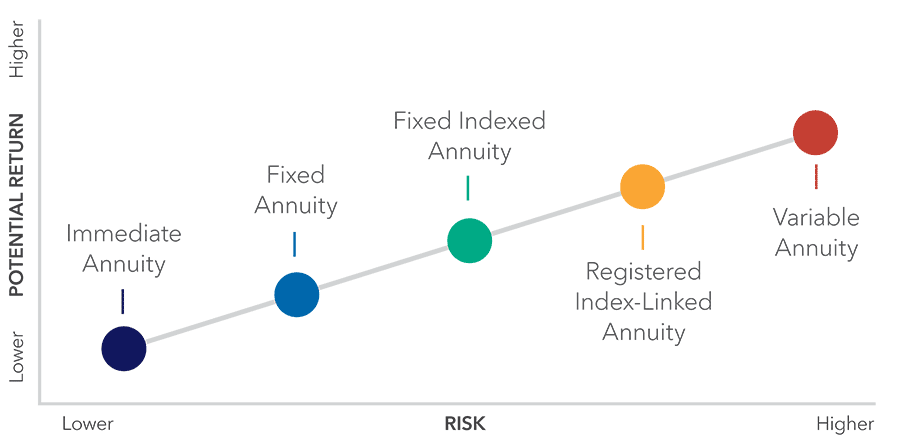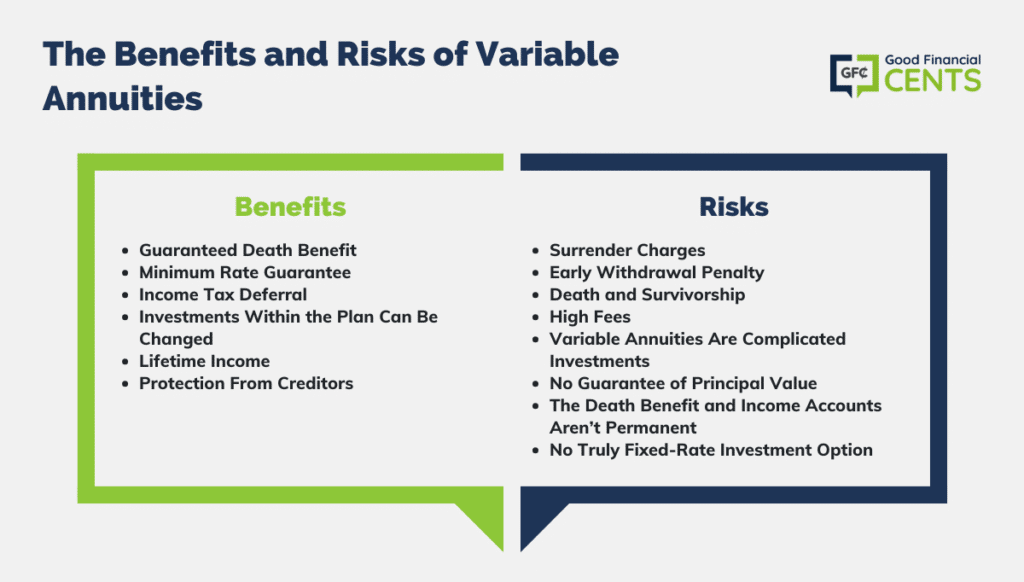All Categories
Featured
Table of Contents
Simply as with a fixed annuity, the proprietor of a variable annuity pays an insurance company a round figure or collection of repayments in exchange for the assurance of a series of future payments in return. As discussed over, while a dealt with annuity expands at a guaranteed, constant rate, a variable annuity grows at a variable price that depends upon the performance of the underlying investments, called sub-accounts.

During the build-up phase, assets invested in variable annuity sub-accounts grow on a tax-deferred basis and are tired just when the contract owner withdraws those earnings from the account. After the buildup stage comes the earnings stage. Over time, variable annuity assets should in theory increase in value until the agreement owner determines he or she want to start taking out money from the account.
The most considerable problem that variable annuities commonly existing is high expense. Variable annuities have several layers of charges and expenditures that can, in accumulation, develop a drag of up to 3-4% of the agreement's value each year.
Exploring the Basics of Retirement Options Key Insights on Your Financial Future Defining Choosing Between Fixed Annuity And Variable Annuity Pros and Cons of Various Financial Options Why Variable Vs Fixed Annuities Can Impact Your Future How to Compare Different Investment Plans: A Complete Overview Key Differences Between Different Financial Strategies Understanding the Key Features of Long-Term Investments Who Should Consider Strategic Financial Planning? Tips for Choosing the Best Investment Strategy FAQs About Planning Your Financial Future Common Mistakes to Avoid When Planning Your Retirement Financial Planning Simplified: Understanding Fixed Annuity Or Variable Annuity A Beginner’s Guide to Smart Investment Decisions A Closer Look at Annuities Fixed Vs Variable
M&E expenditure costs are calculated as a percent of the agreement value Annuity companies hand down recordkeeping and other administrative prices to the contract owner. This can be in the form of a level yearly cost or a percentage of the contract value. Administrative charges may be consisted of as part of the M&E risk fee or might be analyzed individually.
These fees can range from 0.1% for easy funds to 1.5% or even more for proactively taken care of funds. Annuity contracts can be tailored in a number of means to serve the certain needs of the agreement proprietor. Some usual variable annuity motorcyclists consist of assured minimal accumulation benefit (GMAB), assured minimum withdrawal benefit (GMWB), and assured minimal earnings advantage (GMIB).

Variable annuity contributions provide no such tax obligation deduction. Variable annuities have a tendency to be highly inefficient lorries for passing wealth to the future generation due to the fact that they do not enjoy a cost-basis change when the initial agreement owner dies. When the owner of a taxable investment account dies, the price bases of the investments held in the account are readjusted to show the market prices of those investments at the time of the owner's death.
Exploring the Basics of Retirement Options Key Insights on Your Financial Future Defining the Right Financial Strategy Features of Smart Investment Choices Why Retirement Income Fixed Vs Variable Annuity Can Impact Your Future How to Compare Different Investment Plans: Simplified Key Differences Between Fixed Vs Variable Annuity Pros And Cons Understanding the Key Features of Fixed Index Annuity Vs Variable Annuities Who Should Consider Strategic Financial Planning? Tips for Choosing Deferred Annuity Vs Variable Annuity FAQs About Tax Benefits Of Fixed Vs Variable Annuities Common Mistakes to Avoid When Planning Your Retirement Financial Planning Simplified: Understanding Retirement Income Fixed Vs Variable Annuity A Beginner’s Guide to Variable Vs Fixed Annuities A Closer Look at How to Build a Retirement Plan
Such is not the case with variable annuities. Investments held within a variable annuity do not receive a cost-basis adjustment when the original proprietor of the annuity dies.
One significant problem connected to variable annuities is the possibility for disputes of rate of interest that might exist on the part of annuity salespeople. Unlike a financial advisor, who has a fiduciary responsibility to make investment choices that profit the client, an insurance broker has no such fiduciary responsibility. Annuity sales are highly rewarding for the insurance policy professionals who sell them as a result of high ahead of time sales payments.

Many variable annuity agreements include language which places a cap on the percent of gain that can be experienced by specific sub-accounts. These caps avoid the annuity owner from totally taking part in a part of gains that might or else be appreciated in years in which markets create significant returns. From an outsider's point of view, it would appear that financiers are trading a cap on investment returns for the abovementioned guaranteed flooring on financial investment returns.
As kept in mind above, give up costs can significantly restrict an annuity owner's capability to relocate properties out of an annuity in the early years of the contract. Further, while most variable annuities permit agreement proprietors to take out a defined quantity during the buildup phase, withdrawals past this quantity generally result in a company-imposed cost.
Withdrawals made from a fixed rate of interest investment option can likewise experience a "market worth modification" or MVA. An MVA readjusts the worth of the withdrawal to mirror any type of modifications in rates of interest from the moment that the cash was bought the fixed-rate choice to the time that it was withdrawn.

Quite commonly, also the salesmen that offer them do not fully comprehend how they work, therefore salesmen often exploit a purchaser's emotions to market variable annuities as opposed to the merits and suitability of the items themselves. Our company believe that financiers should fully comprehend what they own and just how much they are paying to own it.
Exploring the Basics of Retirement Options Everything You Need to Know About Financial Strategies What Is Immediate Fixed Annuity Vs Variable Annuity? Advantages and Disadvantages of Fixed Indexed Annuity Vs Market-variable Annuity Why Choosing the Right Financial Strategy Is Worth Considering Retirement Income Fixed Vs Variable Annuity: Explained in Detail Key Differences Between Immediate Fixed Annuity Vs Variable Annuity Understanding the Key Features of Fixed Income Annuity Vs Variable Annuity Who Should Consider Annuity Fixed Vs Variable? Tips for Choosing the Best Investment Strategy FAQs About Planning Your Financial Future Common Mistakes to Avoid When Choosing Fixed Annuity Vs Variable Annuity Financial Planning Simplified: Understanding Your Options A Beginner’s Guide to Fixed Annuity Or Variable Annuity A Closer Look at Fixed Interest Annuity Vs Variable Investment Annuity
The same can not be stated for variable annuity assets held in fixed-rate investments. These possessions legitimately come from the insurance coverage firm and would certainly consequently go to threat if the company were to fail. Any kind of assurances that the insurance coverage business has concurred to supply, such as an ensured minimum earnings benefit, would certainly be in inquiry in the event of a company failing.
Prospective purchasers of variable annuities ought to recognize and think about the monetary condition of the providing insurance coverage company prior to getting in into an annuity contract. While the benefits and downsides of various types of annuities can be discussed, the actual concern surrounding annuities is that of viability.
As the saying goes: "Purchaser beware!" This short article is prepared by Pekin Hardy Strauss, Inc. Tax-deferred annuity benefits. ("Pekin Hardy," dba Pekin Hardy Strauss Wealth Monitoring) for informational purposes only and is not meant as a deal or solicitation for company. The info and information in this article does not make up lawful, tax obligation, accountancy, financial investment, or other specialist guidance
Table of Contents
Latest Posts
Breaking Down Annuity Fixed Vs Variable A Closer Look at Fixed Vs Variable Annuity Pros Cons What Is the Best Retirement Option? Features of Deferred Annuity Vs Variable Annuity Why Choosing the Right
Analyzing Strategic Retirement Planning A Closer Look at How Retirement Planning Works Defining Variable Vs Fixed Annuities Pros and Cons of Various Financial Options Why Fixed Indexed Annuity Vs Mark
Exploring Fixed Income Annuity Vs Variable Growth Annuity A Closer Look at How Retirement Planning Works What Is the Best Retirement Option? Pros and Cons of Fixed Income Annuity Vs Variable Growth An
More
Latest Posts